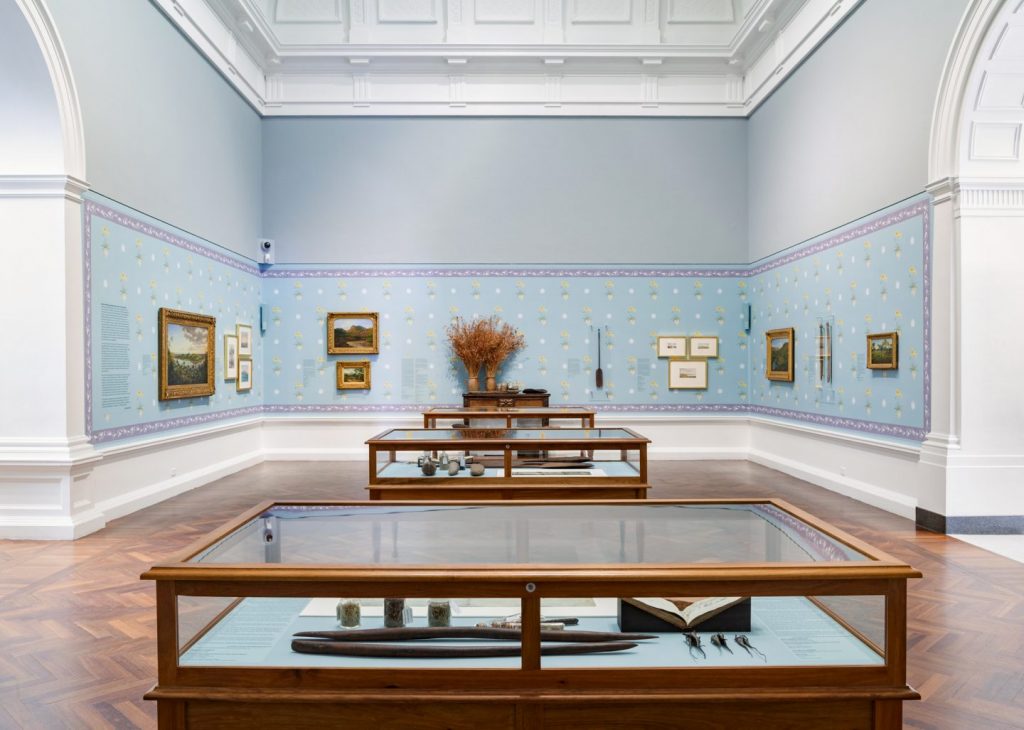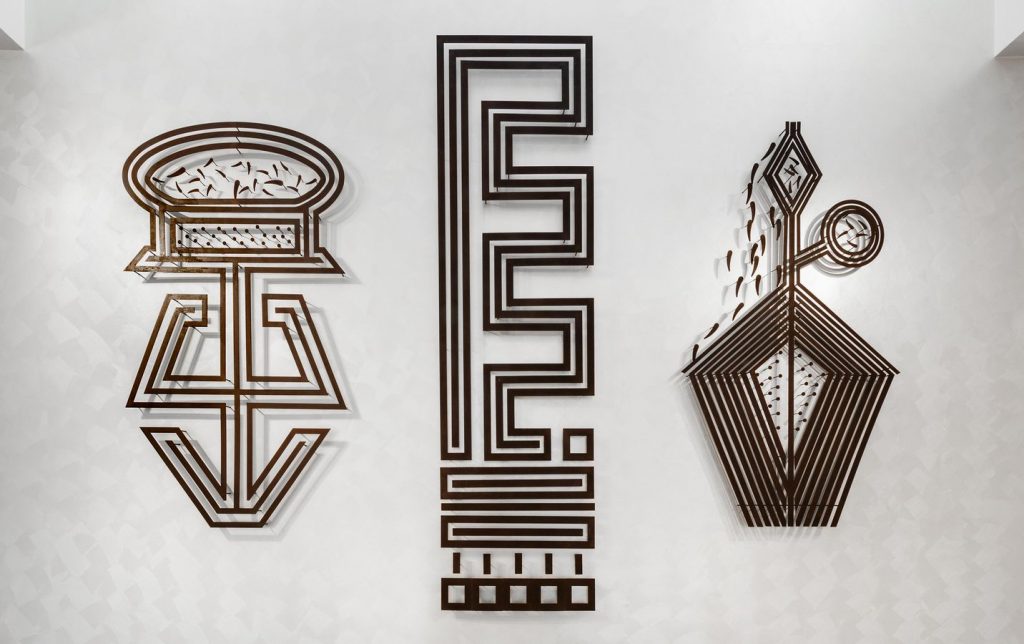
Installation view: Bunha-bunhanga: Aboriginal agriculture in the south-east, Tarnanthi 2019, Art Gallery of South Australia, Adelaide.
Tarnanthi at AGSA presents works of artistic excellence, creative daring and groundbreaking innovation by Aboriginal and Torres Strait Islander artists from across the country. This unmissable experience begins from the moment visitors enter the Gallery.
Vestibule
An imposing sculptural linocut by Brian Robinson greets visitors inside the entrance, alongside new work by Damien Shen.
Gallery 1
Bunha-bunhanga reveals how Aboriginal agriculture shaped the Australian landscape over millennia. This is the first presentation through visual art of the groundbreaking research into pre-colonial land use by Uncle Bruce Pascoe and Bill Gammage. It brings together historical landscape paintings and rarely seen Aboriginal agricultural tools amid a soundscape of seed grinding and Wiradjuri spoken word, through the curation of artist-researcher Jonathan Jones.
Gallery 7
Darrell Sibosado presents large-scale steel sculptural reimaginings of pearl-shell carving designs from the Kimberley coast. Pauline Sunfly represents her Western Desert homeland in bold graphic patterns and vivid blocks of colour.
Gallery 8
In a dialogue across generations, Western Aranda watercolourists respond to historical ‘Hermannsburg School’ works in a tribute to the legacy of Albert Namatjira.
Gallery 9
Tiwi artists demonstrate their rich artistic tradition with an installation of carved Pukamani ceremonial tutini (poles) and painted tunga (bark baskets). Nearby are Garry Sibosado’s monumental incised pearlshell works and paintings by Peter Mungkuri and Judy Watson.
Gallery 10
Nyaparu (William) Gardiner honours the stockman and the strikers of the Pilbara in his endearing paintings and drawings.
Gallery 11
Peggy Griffiths-Madij’s paintings present an immersive vision of her Miriwoong homeland in the East Kimberley, while Ryan Presley’s Blood Money paintings reimagine Australia’s national currency as a celebration of Aboriginal history.
Atrium Breezeway
Etchings of intricate pearl shell carvings by Garry Sibosado and Darrell Sibosado.
Downstairs galleries 22–25
The must-see exhibition Gurruṯu reveals cutting-edge Yolŋu contemporary art from north-east Arnhem Land, with works including complex etchings of traditional designs on aluminium panels, interactive moving-image projections, an award-winning video in Yolŋu sign language, and audacious bark paintings in the vivid pink of leftover photocopier toner. Also downstairs are the Dhawuṯ display of Yolŋu bark paintings, a fun short film sharing Iwantja women’s love of pop culture, Ngupulya Pumani’s ambitious triptych, Robert Fielding’s sandblasted car-wreck sculptural work Mutaka, uplifting paintings and semi-animated videos from Alice Springs’ Town Camps and Thea Anamara Perkins’ poignant portraits of Town Camp artists. There is also the moral kapow! of teenager Layne Dhu-Dickie’s Aboriginal comic-book superhero Captain Hedland, wonderful wood carvings by Badger Bates, Miriam Charlie’s confronting images from her community of Borroloola, new works from Tony Wilson and Sandra Saunders, and memories of frontier conflicts given form in wood, paintings and tjanpi (woven grass).

Darrell Sibosado, Aalingoon (Rainbow Serpent), 2019, Lombadina, Western Australia, corten steel, 550.0 x 300.0 cm (overall); © Darrell Sibosado, photo Saul Steed
SOURCE: Art Gallery of South Australia.